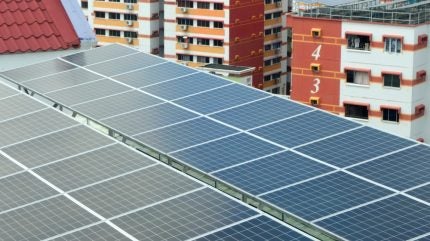
EDP Renewables (EDPR) announced last week (26 August) that it will renew its partnership with Microsoft on Singapore’s largest solar energy portfolio, SolarNova.
This second agreement will see Microsoft purchase 100% of the renewable energy exported to the grid from EDPR’s SolarNova 8 project, comprising up to 200MW-peak (MWp) of capacity.
EDPR, an arm of Portuguese electric utilities company EDP, was awarded Phase 8 of Singapore’s SolarNova programme in February. The company will install solar panels on more than 1,000 public housing buildings and more than 100 government-owned buildings.
The energy generated will be used to fully power common services during the day.
Phase 8 is both the largest solar project in Singapore and the largest initiative under the government’s SolarNova programme.
EDP and EDPR CEO Miguel Stilwell d’Andrade commented: “We are taking a step towards achieving Singapore’s sustainability goals of at least 2GW-peak of solar energy by 2030. Contracting with Microsoft is a catalyst for accelerating the energy transition and to continue investing in the region.”
Microsoft and EDPR’s partnership in Singapore dates back to 2018, marking Microsoft’s first renewable energy deal in Asia and building on decades of company investment in the country.
The SolarNova programme was launched in 2014 by the Singaporean Government, led by the Economic Development Board, the Energy Market Authority (EMA) and HDB.
SolarNova is expected to generate an estimated 420 gigawatt-hours of solar energy annually, equivalent to 5% of Singapore’s total energy consumption and reduce the country’s carbon emissions by more than 96,000 tonnes annually.
After passing its solar target of 220MWp by 2020, the HDB announced a new target of 540MWp by 2030. In a previous statement, HDB CEO Tan Meng Dui said: “Our journey in building up our solar capabilities started on a small scale. We strive to install solar panels on as many HDB blocks as possible.”
Singapore’s commitment to solar energy
Beyond providing solar photovoltaic (PV) systems to public housing, SolarNova aims to develop Singapore’s solar industry.
The programme will contribute towards the national solar targets of 1.5GWp by 2025 and 2GWp by 2030 as set by the government under the Singapore Green Plan.
A spokesperson from Singapore’s EMA told Power Technology that solar energy is “Singapore’s most viable renewable energy source, with solar deployment growing significantly over the years”.
“Our solar installed capacity has increased by about ten-times in the last seven years, from 126MWp in end-2016 to 1.17GWp as of end-2023.”
Power Technology’s parent company GlobalData reveals that by 2035 the market for Singapore’s renewable power sources is expected to rise at a compound annual growth rate of 9.96% and reach a cumulative installed capacity of 3.37GW.
This growth is dominated by solar PV, which GlobalData predicts will contribute 78% of Singapore’s renewable power installed capacity by 2035, with the remainder produced by biopower.
The expansion of solar panels suits the geographical constraints of the small island-nation, which has one of the highest population densities in the world and limited space for ground-scale projects.
In addition to this expansion, Singapore has made well-rounded efforts to develop its solar sector. The EMA explained that “as solar output could fluctuate due to factors such as sunlight intensity, cloud cover and shade”, the country has also “deployed a 285MWh [megawatt-hour] energy storage system and enhanced solar forecasting capabilities to address solar intermittency”.
As part of efforts to diversify its energy sources away from fossil fuels, Singapore is also importing renewable energy from countries across the Asia-Pacific (APAC) region.
On 5 September, the EMA announced the approval of five projects based in Indonesia to export a total of 2GW of low-carbon electricity to Singapore, with two further approvals pending.
According to a report by energy think tank Ember, Singapore’s financial and research strength could spearhead APAC’s energy transition, which will require an estimated $200bn to upgrade grid infrastructure by 2030.



